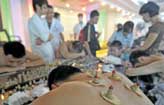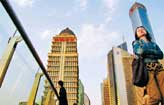Economy
Despite mixed market pressures, June sales rebound
Updated: 2011-07-25 14:55
(China Daily)
After a downturn in May, there were concerns that vehicle demand in China would continue to be sluggish in the months to follow.
But the June market turned out to be stronger than expected.
Light vehicle sales grew 5 percent year on year to 1.4 million units, completing the first half with 9 million vehicles sold, 6 percent more than the same period in 2010.
But sales of cars and light commercial vehicles showed a stark contrast.
Car demand rose 14 percent year on year to 1 million units in June as light commercial vehicle volume shrank 13 percent to 374,000 units.
Passenger vehicle sales in the first half of the year totaled 6.3 million units, up 11 percent from a year ago, while light commercial vehicle sales declined 5 percent to 2.6 million units.
With the rebound in demand in June, the seasonally adjusted annualized rate - a projection of full-year sales - increased to 16.3 million units from 15.9 million units in May.
Inventory was one of the major reasons for June's rise in passenger vehicle deliveries.
With growth in retail sales slower than most automakers estimated, inventories continued to rise from the beginning of this year. Before it became too late, deliveries to dealers were cut throughout the industry in May.
With pressure on dealers eased, wholesale deliveries were then increased again in June.
Strong sales of imports and made-in-China luxury cars were also important to driving growth.
Surging demand is coming from replacement or additional purchases by families with rising income. Many bought their first car between 2005 and 2008 during the last wave of rising sales.
Japanese carmakers
Most Japanese carmakers are now recovering from the parts shortage triggered by the earthquake and tsunami in March.
Honda, Toyota and Nissan all achieved month-on-month growth surpassing 20 percent, while Toyota and Nissan also realized 10 percent and 20 percent growth year on year, respectively.
Retail prices for passenger vehicles fell slightly in June. Dealers of most brands increased incentives to meet their half-year sales target.
Only the average transaction price of SUV segment increased due to premium charges for the VW Tiguan and Audi Q5 and reduced discounts on the Nissan Qashqai and Chery Tiggo.
In the first half of 2011, Chinese and Japanese brands underperformed others.
Japanese brands were mostly affected by the earthquake, but the decline in market share for Chinese brands is more complex.
The top reason is higher inventories. Average inventory levels at Chinese brand dealers are nearly 1.5 times that in global brands. Reduced subsidies and a narrowing gap with global brands in retail prices have slowed sales of Chinese brands.
Adjustments in product strategy is another factor.
Chery, BYD and Geely are all trying to improve their brand prestige by marketing more "high-end" models such as the Chery G5, Geely EC8 and BYD L3. Sales of those models can hardly match their low-end models.
Since new subsidies are unlikely this year, overall vehicle demand in the second half will mostly be impacted by seasonal factors.
For this year, we forecast passenger sales to rise 9 percent to 13 million units and light commercial vehicle sales decline 5 percent to 5 million units.
The author is a senior analyst at JD Power and Associates

Specials

Turning up the heat
Traditional Chinese medicine using moxa, or mugwort herb, is once again becoming fashionable

Ciao, Yao
Yao Ming announced his retirement from basketball, staging an emotional end to a glorious career.

Financial sector short of talent
Lack of skilled professionals in Shanghai inhibiting the city's development as a financial hub